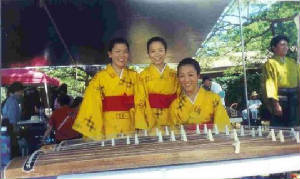|
Kutu
This 13 string
horizontal zither called kutu was introduced to Okinawa by the Japanese during the 18th century. During the
Nara period, which dates back to the 8th century, China introduced this ancient instrument to Japan. The kutu
or koto in Japanese is often times compared to the mystical dragon that appears in Oriental art and folklore.
Certain parts of this instrument are named after parts of the dragon, for instance, ryuzetsu meaning dragon's tongue,
ryuko, the dragon's back, and ryubi, the dragon's tail (Andagi 99).
The Kiri and
Paulownia are types of wood commonly used for all kutu. There are two types of standard 13-string kutu
used today. "They are named for the school from which they evolved, the Ikuta and Yamada." There are a few characteristics
that set them apart from one another. The Ikuta is generally longer, and it has a keyhole shaped sound-hole while the
Yamada has a round opening. The Yamada has a rounded "tail" of the instrument, while the Ikuta is flat. The bridges
or kotoji that brace the strings on the surface also differ in that the Yamada is larger and heavier, although, the
kotoji or bridges can be made in a variety of woods, ivory, or plastic for either instrument (Andagi 99).
One of the major differences
is the sound quality. No two instruments will sound the same. The quality of sound will depend on the cut, the
location of the cut, the aging process, and lastly the joining, wood filling or patching process. Craftsmen consider
the side of the tree that has been exposed the most to the sun, and seasonal changes, "to be the strongest and best part of
the tree." Due to imperfections, holes and fissures must be filled, if not corrected the sound quality may be poor.
Beauty is added to the instrument using precious woods, gold, silver, bronze, and inlays of ivory, mother of pearl or gold
leaf. No matter which instrument, they are surely works of art (Andagi 99).
| Click picture to view |

|
| 3 Kutu players at the 22nd Annual Okinawan Festival |
Sanshin
The sanshin
is a three-stringed instrument that looks a lot like a banjo. This instrument is believed to have originated from China,
to mainland Japan, and then on to Okinawa. The sanshin was originally covered with layers of rice paper.
Today, the instrument is covered with snakeskins. In Japan, these instruments are covered with cat skins and are called
shamisen (Andagi 101).
The sanshin gave rise to the development of Okinawan classical music.
The sounds that emanate from this instrument have been compared to the sound of a Buddhist minister reading a sutra.
The sanshin player must truly be talented to play this instrument, as well as sing along. Unlike most
instruments one can play and sing as the tunes are harmonized, however, Okinawan classical music is not. Song notes
can rise while the sanshin notes can fall and vice versa. One must also breath different, as breaths are taken
at specific points, therefore thoracic breathing is a must. To do this a kneeling position known as seiza is
done. This seiza position "offers the sanshin player the best posture to develop enough pressure in the lower
stomach to sing Okinawan classical songs." Many of the sanshin players tend to live healthy and longer lives
due to the benefits of singing, as well as the thoracic breathing. The beautiful classical music is a plus (Andagi 101).
|

